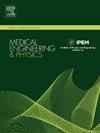Comparison of wired and wireless electromagnetic hand motion tracking in central venous access: Are they equivalent enough to cut the cord?
IF 1.7
4区 医学
Q3 ENGINEERING, BIOMEDICAL
引用次数: 0
Abstract
Purpose
This study aims to compare a commercially available wired and wireless tracker in motion analysis of interventional radiologists performing simulated ultrasound-guided central venous access.
Methods and material
Interventional radiologists were asked to volunteer for the study. Participants were asked to place central venous lines on a commercially available, standardized manikin as their needle hand and ultrasound probe motion were recorded using electromagnetic trackers. Each participant performed a total of 10 trials, with 5 trials recorded using a wired tracker and 5 using a wireless tracker. Institution-developed software was used to calculate established motion metrics (path length and number of movements). The motion metrics from the two trackers were compared.
Results
Seven interventional radiologists participated in the study. Path length (wireless vs. wired: 773.1 cm ± 85.7 cm vs. 959.5 cm ± 303.6 cm, p < 0.001) and number of movements (193 ± 52 vs. 231 ± 50.5, p = 0.001) differed significantly between the two trackers; however, the time to complete the procedure (51.8 s ± 14.8 s vs. 49.8 s ± 10.5 s, p = 0.68) was similar across trackers.
Conclusion
The motion metrics of the same operators differ significantly between wired and wireless trackers. Accounting for the sampling frame rate and the frame efficiency of the wireless sensors can provide comparable motion data.
有线和无线电磁手部运动跟踪在中心静脉通路中的比较:它们是否足以切断脐带?
目的:本研究旨在比较市售有线和无线跟踪器在进行模拟超声引导中心静脉通路的介入放射科医生的运动分析。方法和材料介入放射科医生被要求自愿参加这项研究。参与者被要求在市售的标准化人体模型上放置中心静脉线,他们的针手和超声探头的运动被用电磁跟踪器记录下来。每个参与者总共进行了10次试验,其中5次使用有线跟踪器记录,5次使用无线跟踪器记录。使用机构开发的软件计算已建立的运动指标(路径长度和运动次数)。比较了两种跟踪器的运动指标。结果7名介入放射科医师参与研究。路径长度(无线vs有线:773.1 cm±85.7 cm vs 959.5 cm±303.6 cm;0.001)和运动次数(193±52 vs. 231±50.5,p = 0.001)在两种追踪器之间差异显著;然而,完成程序的时间(51.8 s±14.8 s vs 49.8 s±10.5 s, p = 0.68)在不同追踪器之间相似。结论有线追踪器与无线追踪器对同一操作者的运动指标有显著差异。考虑到无线传感器的采样帧率和帧效率,可以提供可比较的运动数据。
本文章由计算机程序翻译,如有差异,请以英文原文为准。
求助全文
约1分钟内获得全文
求助全文
来源期刊

Medical Engineering & Physics
工程技术-工程:生物医学
CiteScore
4.30
自引率
4.50%
发文量
172
审稿时长
3.0 months
期刊介绍:
Medical Engineering & Physics provides a forum for the publication of the latest developments in biomedical engineering, and reflects the essential multidisciplinary nature of the subject. The journal publishes in-depth critical reviews, scientific papers and technical notes. Our focus encompasses the application of the basic principles of physics and engineering to the development of medical devices and technology, with the ultimate aim of producing improvements in the quality of health care.Topics covered include biomechanics, biomaterials, mechanobiology, rehabilitation engineering, biomedical signal processing and medical device development. Medical Engineering & Physics aims to keep both engineers and clinicians abreast of the latest applications of technology to health care.
 求助内容:
求助内容: 应助结果提醒方式:
应助结果提醒方式:


